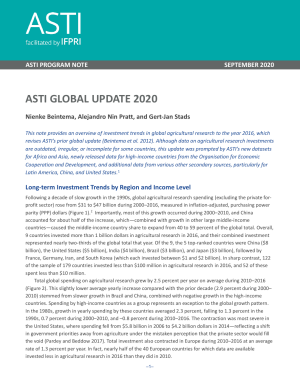Authors:
Nienke Beintema, Alejandro Nin Pratt, and Gert-Jan Stads
Year:
2020
Publisher
International Food Policy Research Institute (IFPRI)
Back to:
After a decade of sluggish growth in the 1990s, global agricultural research spending grew by 50 percent during 2000–2016, mostly driven by China and other large middle-income countries. Concurrently, spending in high- income countries stalled, ending the period with negative growth, while global investments by the private-for profit sector doubled. These trends caused the middle-income country share of total global investments to increase from 40 to 58 percent during the 2000–2016 period. Analysis of the intensity of research investment, based on ASTI’s intensity index, indicates that the global gap in agricultural research investment was 34 percent of the world’s attainable investment in 2016, ranging from 25 percent in high-income countries to 39 in low- income countries. APC recorded the lowest investment gap (only 26 percent), which reflects the impact of China’s and India’s high levels of investment in their respective systems. More detailed analyses of low- and middle-income countries show that underinvestment is prevalent among countries with small and medium-sized research systems. These findings suggest that closing the investment gap will depend on sustained investment growth in large countries, such as Brazil, China, and India, and faster growth in other countries with large research systems. Countries with both small research systems and low potential to increase their investment in agricultural research will need to adopt alternative strategies—such as collaboration with countries and regions that share mutual research needs and goals—in order to acquire the knowledge and technologies they need to achieve agricultural development and growth in the coming decades.

